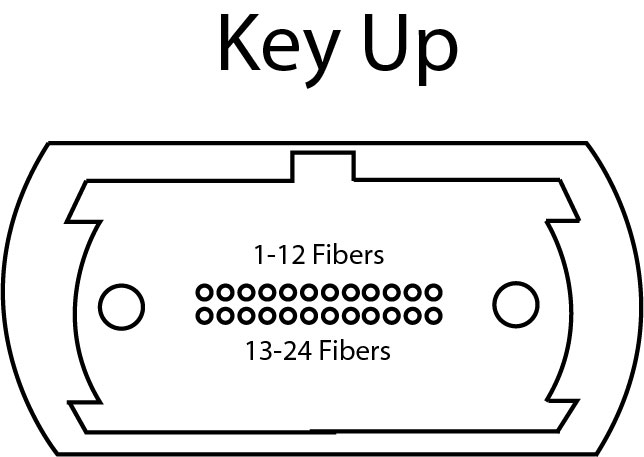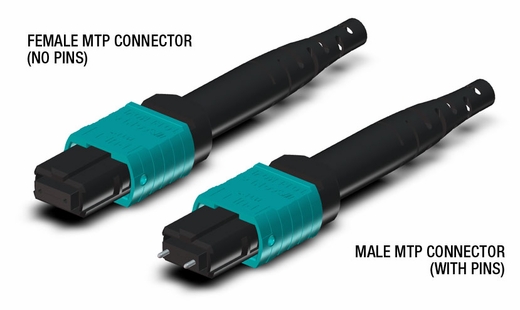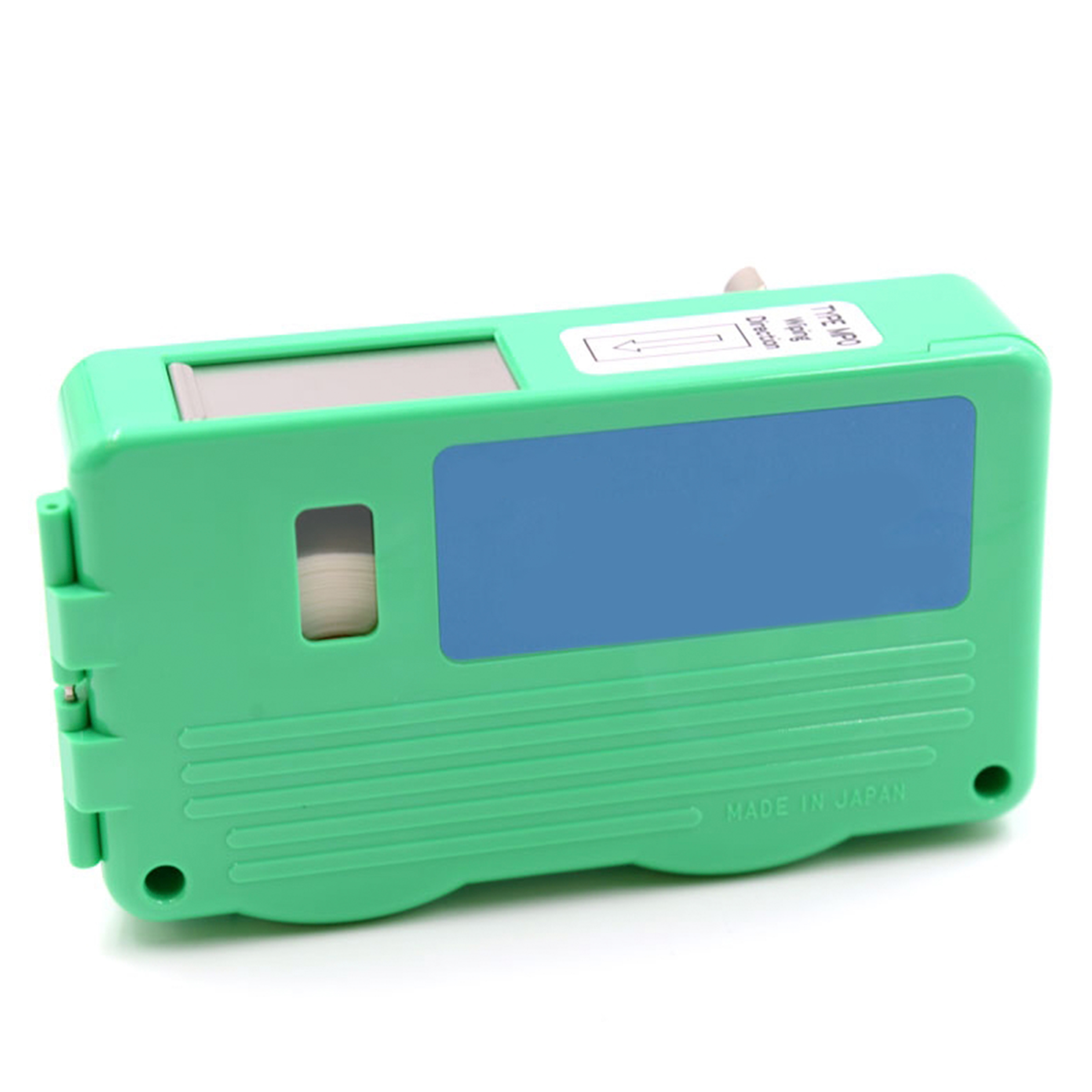Fiber Optic: MTP/MPO Multi-fiber Connectors Explained
Created on: Jun 14, 2019
Introduction
MTP and MPO connectors offer a high data transfer solution for data centers, mainly for "trunk" or"break-out" purposes to conserve space. They are identical in application, and offer 40G to 100G of data transfer over 12 or 24 fibers. In this article we will review the difference between the two options, their common applications and proper maintenance of these Multi-Fiber Ferrules. These fiber connectors come in both single and multimode fiber applications.
Important Terms
Connector Key:
MTP/MPO connectors have a "key" or non-symmetrical face with an extrusion on one side. This is to prevent connection in reverse polarity, which would cause cross talk and ineffective data transfer. When the Key is facing up this is known as "key up" and from this orientation the fibers are arranged from left to right and top to bottom. For MTP/MPO's with 8,12, and 24 fibers, the key is located in the center. For connectors with 16 or 32 fibers, the "key up" orientation has the key located on the left.
 Displayed is a 24 fiber MTP orientation as explained above. If this were a 16 or 32 fiber connector, the key would we on the left side instead of the center.
Displayed is a 24 fiber MTP orientation as explained above. If this were a 16 or 32 fiber connector, the key would we on the left side instead of the center.
Polarity
The whole function of the fiber is to send data from one transceiver to a receiving transceiver. When connectors with multiple fibers are connected, this is especially important as channels can easily be crossed and data will be sent in the wrong direction. To solve this issue, MTP/MPO connectors have polarity through the connector key. The key/ polarity can be arranged in three different ways:
- Type A (straight-through method) is when the keys are arranged Key Up to Key Down at the point of connection, and P1 will end at P1. Commonly used in Data Centers, done by using an adapter.
- Type B (inverted method) is when the the keys are arranged Key up to Key Up at the point of connection and P1 will end at P12. Commonly used in Data Centers, done by using an adapter.
- Type C (twisted pair method) is when each fiber pair is twisted, so P1 will end at P2 and vise versa. This is the least common polarity type and is only found on Duplex scenarios.
Connector Pins
Single Fiber connectors are all male and do not have a distinguishing factor to call them "male" or "female", however the MTP/MPO connectors have pins which align the fibers and are thus are distinguished by traditional Plug/Connector terminology.
 The Pins are classified as the "Male" end, while the guide holes are considered the "female" connector.
The Pins are classified as the "Male" end, while the guide holes are considered the "female" connector.
MTP vs. MPO
 The MTP and MPO connectors are identical, however as described below, the MTP connector has superior performance due to advanced mechanical and optical engineering.
The MTP and MPO connectors are identical, however as described below, the MTP connector has superior performance due to advanced mechanical and optical engineering.
MPO or "Multi-Fiber Push On" (defined by IEC-61754-7) Ferrules have a vast amount of options to fit each scenario. MPO connectors are designed for 4-, 8-, 12-, 24- , 36-, 48-, 96-, and 144 multi-fiber ribbon applications. The mating/coupling options of these connectors include Female-Female, Male-Male and Female-Male connection types.
MTP or "Multi-Fiber Termination Push On" is defined under the same standard as MPO, however is a trademarked brand of the MPO connector. The MTP is an MPO, however it is regarded as the superior type of MPO connector for a few reasons.
The MTP Ferrule:
- Has a floating ferrule to improve mechanical connection performance.
- Uses rigid stainless steel guide pins (Male End) that hold their original placement ensuring a perfect ferrule connection.
- Has a metal pin clamp with features that can center the push spring.
- Has 4 options of strain reliefs to fit each application.
- The spring design maximizes ribbon clearance to prevent fiber damage.
- Has a removable housing.
Common Applications
Since the MTP/MPO can handle upwards of 72 fibers, it is significantly easier to manage than standard Singlemode/Multimode fiber and is functionally superior in certain applications. Data Center's typical use for this technology is in "MTP/MPO Trunk Cables". These are standard cables with MTP/MPO connectors on each end. These are used for connecting switch to switch or from switch to breakout panel. The other common use for MTP/MPO is in harness or "breakout" cables. A single MTP/MPO connector is attached to multiple connectors. These connectors can be at different lengths and different styles, learn more about all the available fiber connector options. This is especially useful for conserving space, however it can be expensive as these are usually custom made.
 Displayed is a MTP Breakout Cable with 1 MTP connector splitting into 12 LC-UPC Connectors.
Displayed is a MTP Breakout Cable with 1 MTP connector splitting into 12 LC-UPC Connectors.
Proper Cleaning/ Maintenance
Due to the complexity and sensitivity of fiber ferrules, and multi-fiber ferrules in particular, a proper inspection/ cleaning routine would be beneficial in any application over time. Particles can create imperfections in the surface between ferrule tips and increase attenuation. According to the NTT Advanced Technology research conducted in 2010, 80% of fiber network problems are due to improper cleanliness during installation/use. The two main ways of cleaning Fiber Ferrules/Connectors are Cassette Cleaners and the One Push Cleaner.
The Cassette Cleaner can effectively clean almost every fiber optic connector on the market. In is a concealed roll of cloth that is rolled on the ferrule tip in order to clean the ferrule connector or inlet before connection. These include LC, MU, SC, FC, ST, MPO/MTP, and other connectors with an exposed ferrule. The One-Push Cleaner works in a similar way, however it is a hand held device with a "thumbwheel" to move the cloth vs. rubbing the ferrule over the exposed cloth on a cassette cleaner.
 Cassette Cleaner
Cassette Cleaner One-Push Cleaner
One-Push Cleaner
Conclusion
In conclusion, MTP/MPO are commonly used for either transferring data through many channels from one location to another or from one location to several through "breakout" cables. When using MTP/MPO connectors, polarity and cleanliness are essential to overall performance. MTP is the same thing as MPO, MTP is just a trademarked type of MPO that has superior features to the standard MPO connectors and is therefore recommended for use in most scenarios. Polarity and mating techniques between each MTP/MPO connector can affect the performance of the data transfer, and if you are unsure you should educate yourself further before making and purchasing decisions. When you are ready, shop our wide variety of MTP/MPO Fiber Cables. Which one will best suite your needs? If you are unsure, please contact sales@worldcordsets.com

Author:
Brian Sackett
Marketing & Development
